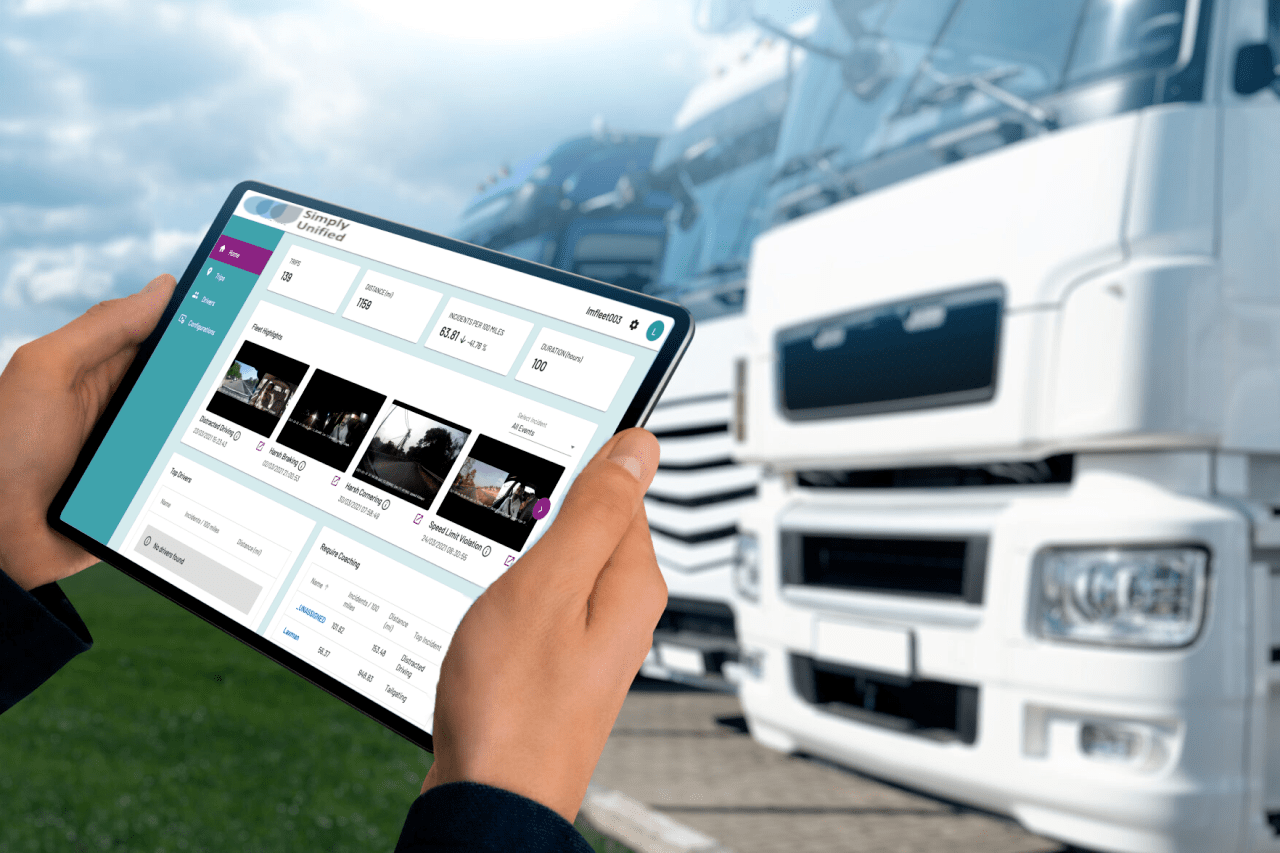For any organisation, the safety of drivers, passengers, and pedestrians is paramount. Apart from accident prevention, these measures ensure legal compliance whilst maintaining a good reputation and brand image. Enter video telematics, a powerful tool for drivers and fleet managers to avoid unfair accusations.
Video telematics involves fleet tracking, fusing artificial intelligence with cameras and analytics. When appropriately implemented, security teams and managers can design a strategy that reduces risky driver behaviours using real-time insights – thus preventing collisions, protecting roads, and making the fleet safer.
The Link Between Video Telematics and Fleet Safety
Video telematics combines data acquired from telematics (a portmanteau of “telecommunications” and “informatics” with high-definition video footage from dashcams. It enables fleet managers and operators to understand driver behaviour and give personalised driver training.
Video telematics utilises dashcams and sensors, including GPS systems, communication and connectivity, and digital storage. The dashcam’s job is to record the event to make it available to fleet managers, enabling them to check for risky driver behaviours like speeding, harsh acceleration, and aggressive braking.
Many video telematics platforms and devices can be customised to align with the risk tolerance of a specific business. For example, you can set a threshold for cameras to record speeding events only if the driving speed is above 10% of the posted limit.
Besides simply triggering a video capture, modern cameras can interpret the footage on the fly. This makes video telematics even more powerful as they can detect events happening inside and outside the cabin, which we can categorise into the following:
- Advanced Driver Assistance Systems (ADAS) analyse the event outside the car. Their primary purpose is to provide forward collision warnings, lane departures, and similar assists.
- Driving Behaviour Analysis (DBA) checks GPS data and sensors to record harsh braking, cornering, and other behaviours.
- Driver Monitoring Systems (DMS) utilise cabin-facing cameras to monitor driver practices, such as smoking inside the vehicle, driving whilst tired, or using a mobile phone.
All events can be received by the fleet manager and the driver, depending on the fleet telematics’ configuration. The management can then use the data for analyses and assessments, which can help educate drivers.
For example, a telematics fleet management team can watch live streams of a vehicle’s camera system. Managers can receive instant notifications or clips when harsh braking or any other special event occurs. These real-time insights are precious, as they can be used to avoid dangerous situations.
Identifying Risky Driver Behaviours with Video Telematics
Fleet safety can be jeopardised due to driving mistakes and bad habits, which often include the following:
- Speeding: Some drivers, even though they know the posted speed limit, will drive at an excessive speed. This behaviour is dangerous regardless of the road condition, as it increases the risk of losing control. Speeding also reduces a driver’s ability to react to potential hazards, which can put them or other people in harm’s way.
- Distracted Driving: Texting, talking on the phone, and eating are just some activities that misbehaving drivers commonly perform. Unfortunately, these seemingly benign acts can significantly increase the risk of an accident.
- Fatigued Driving: Tiredness and drowsiness can impair a person’s ability to focus. It’s difficult to react quickly and make the right decision when the driver falls asleep behind the wheel.
- Aggressive Driving: Harsh braking, frequent lane changing, and excessive honking increase collision risk. Sometimes, they invite road rage incidents, so these negative behaviours must be controlled.
- Tailgating: Getting too close to another vehicle increases the likelihood of rear-end collisions. It also causes delayed reactions in case of sudden changes in traffic.
- Seat Belt Mistakes: It’s 2023, and believe it or not, there are still many people who do not wear seat belts. If they do, they are worn improperly. This increases the possibility of serious injuries or even death in an accident.
Detecting driver misbehaviours is easy with video telematics. This technology can be used to gather video evidence, allowing fleet managers to review and evaluate the driver’s behaviour accurately. Fleet telematics data of driver behaviours, such as acceleration, braking, speed, and cornering, along with the video footage, make monitoring drivers easier. The telematics fleet management team can promptly intervene and address potential issues thanks to real-time insights. For example, managers can remind drivers to take a break or stay focused whilst on the road.
Using Real-Time Insights to Enhance Driver Training
Video telematics offers valuable data for driver training and coaching. Managers can review the footage and show some clips to the drivers to highlight their unsafe driving behaviours. They can then be provided with constructive feedback and personalised coaching sessions. This training method is more effective as they are tailored to each driver’s unique needs. It helps them become more aware of their actions and leads to safer driving practices.
Consistent driver training and coaching can improve driver and fleet safety in many ways. As the manager, you can create training programs focusing on driving techniques for accident prevention. Some practices that should be emphasised include scanning the road for potential hazards, maintaining safe distances, and anticipating other drivers’ actions.
Accident Prevention and the Role of Video Telematics
Real-time insights derived from telematics vehicle tracking and behaviour data can be leveraged by identifying patterns and trends. For example, managers can utilise information to see which areas drivers generally exhibit unsafe behaviours. And since drivers are aware they are being monitored, such knowledge can act as a deterrent. They become more cautious and responsible whenever they are behind the wheel.
Another way that video telematics help is in the event of a near-miss incident. The captured footage can provide an objective record of the occurrence, giving fleet managers the information required to understand the cause of the incident. They can then assess the driver’s actions and identify areas for improvement.
The evidence makes it easier to determine liability and settle insurance claims. The company also preserves its good reputation because of the quick response. Furthermore, the incident can be used to implement corrective measures to avoid similar incidents in the future.
Implementing Video Telematics for Improved Fleet Safety
Each business has its own specific needs for video telematics solutions. It’s important to consider a variety of factors to ensure you arrive at the best decision, including:
- Fleet Objectives: What goals do you want to achieve for implementing video telematics? Is it to reduce accidents, eliminate risky driver behaviours, or optimise fleet operations?
- Fleet Requirements: With the objectives specified, determine what the fleet needs to prioritise regarding features and functionalities.
- Video Quality: HD videos are great but may not suit your financial situation. So, factor in your budget without compromising good resolution, as this is crucial for visibility and event reconstruction in case of an incident. Don’t forget that lighting and weather conditions can affect the quality of the footage.
- Coverage: How many camera angles do you need? Ensure your final decision provides comprehensive coverage of the road and the driver.
- Storage: Pick adequate storage to accommodate the volume and retention period of data your fleet will generate. Whatever storage solution you choose should allow easy access and retrieval of video footage, so you can review and analyse it when needed.
- Real-Time Monitoring: We recommend looking for a video telematics solution with real-time monitoring capabilities. Instant alerts are a plus, which let you immediately know about critical events like collisions and speeding.
Analytics and reporting can make a massive difference in improving fleet efficiency and safety. But a significant issue arises here: driver privacy. It’s a crucial consideration that should be addressed and balanced for the driver’s peace of mind.
Therefore, all drivers must know and understand the need for video telematics implementation. They should be informed about its purpose, benefits, and data collection strategies. Explicit consent from drivers should be obtained before deploying the solution to build trust and avoid issues in the future.
Conclusion
Video telematics systems offer excellent benefits for your organisation, no matter the industry. With the telematics data they provide, you gain valuable real-time insights into driver behaviour to promote safer driving and optimise overall fleet operations.
Are you interested in implementing video telematics for your fleet? Call Simply Unified today to learn more about our video telematics service offerings designed to help keep your fleet safe and efficient.







